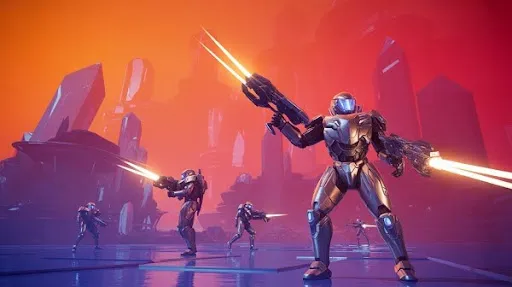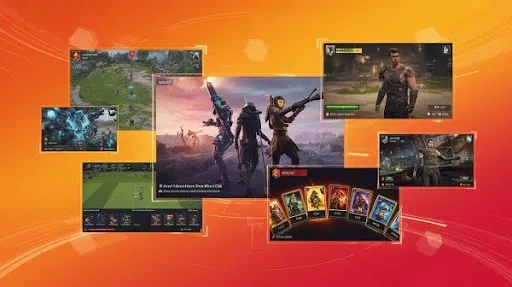Some games don’t stop at launch. They grow, shift, and pull players back in with new reasons to stay hooked. That’s the pull of live service games, a model that changed how studios build, update, and support their titles.
Instead of a one-and-done release, these games stay alive with constant content drops, events, updates, fixes, and social systems that turn casual players into regulars.
For studios like Prolific Studio, this model isn’t only a technical strategy. It blends design, storytelling, community engagement, and even game animation services like tweening in animation, inverse kinematic in animation, and walking animation used to keep content fresh. It creates a cycle where players stay curious because the game feels active, not abandoned.
This blog explores the concept of live service games with a clear lens:
Why they work, what makes them fail, the personalization behind their growth, and how animation, gameplay systems, and content planning turn them into long-term digital experiences.
We’ll break down what live service games are, how they came to be, the cost of supporting them, and the opportunities for studios ready to build something that lasts.
What Are Live Service Games? A Straightforward Breakdown
At their core, live service games are video games designed to keep going long after launch. New content, seasonal features, balance updates, and community-driven changes help them stay relevant for years. They’re different from traditional games that release, get a few patches, and move on to the next sequel.
If someone asks what are live service games, the simple answer is: A game that never settles.
The gameplay updates may include new bosses, characters, limited-time modes, events, cosmetics, zones, raids, or even story chapters. The point is to keep giving players something worth returning for.
Titles like Fortnite, Destiny 2, Warframe, Apex Legends, and Genshin Impact are the most popular examples of live service games. They run seasonal systems, community events, rotating rewards, and ongoing improvements to keep players engaged.
They’re also loaded with regular animation updates, including new walking animation cycles, emotes, cinematics, and 3D animation services that keep each patch looking polished.
The Origin of Live Service Games
Before anyone used the term, the idea started forming inside older multiplayer online role-playing games. Titles like RuneScape, World of Warcraft, MapleStory, and EverQuest offered massive updates packed with new lands, raids, quests, and items. Their developers kept refining these games for years, something players hadn’t seen before at this scale.
Then the idea merged with the rise of the SaaS mindset, software that updates constantly instead of dropping in versions. Games began adopting this style, delivering content through digital distribution instead of physical expansion disks.
This created a foundation:
- Games can survive for years
- Players appreciate ongoing content
- Updates build loyalty
- The studio can grow the project without hitting “reset”
As online gaming improved, studios realized the potential of a long-term model. Better internet speeds, digital stores, and improved animation pipelines (including tweening in animation) made it easier to build and update these games. Suddenly, patches weren’t optional; they became part of a game’s identity.
Core Features that Define Live Service Games
Every studio has its own strategy, but most live service games share similar gameplay features and design choices. These features help them attract new players while giving existing players a reason to stay.
1. Constant Content Updates
Players expect new things to do. This includes:
- New missions
- New maps
- New characters
- New gear or weapons
- Cosmetic skins
- Limited events
- Raids and high-risk activities
These drops function like traditional DLC or game expansions, except they arrive more frequently and are often smaller in size. Instead of waiting a year for a massive expansion, players get content every few weeks or months.
2. Seasonal Systems and Events
Seasons are a huge part of the concept of live service games. They offer:
- Season-based stories
- Battle passes
- Rotating rewards
- Exclusive cosmetics
- Limited-time activities
Holiday events, crossovers, and collaborations also keep the experience exciting. A Fortnite Halloween event feels entirely different from its winter event.
3. Strong Multiplayer and Community Dynamics
Live service titles thrive on social play. Even games that aren’t fully online tend to include:
- Co-op modes
- Clans/guilds
- Friend bonuses
- PvP modes
- Player hubs
- Shared spaces
Players enjoy a sense of belonging. These games push that idea by creating systems that reward teamwork, communication, and long-term community building. The interaction between players becomes content by itself.
4. Frequent Fixes and Balancing Updates
Since live service titles run nonstop, studios must fix bugs, improve systems, and adjust gameplay consistently. Bad balancing or ignored issues can break the player experience overnight.
Updates may include:
- Nerfs and buffs
- Ability changes
- Enemy reworks
- Quality-of-life improvements
- New animation passes
- UI and UX fixes
This constant refinement creates trust. Players want to feel like the studio cares about the experience and isn’t abandoning the game.
Gameplay and Genres of Live Service Games
Not every genre fits the model, but many have embraced it successfully. Shooters rule the space, Fortnite, Destiny 2, Apex, because they’re built for large audiences. Still, the concept works in several genres:
- Action RPGs (Genshin Impact)
- Fighting games (Multiversus)
- Racing games (The Crew 2)
- Sports simulators (FIFA Ultimate Team)
- Survival games (Rust)
- Sandbox games (GTA Online)
Each one uses different approaches, but they all offer similar gameplay features such as:
- Leveling systems
- Skill upgrades
- Gear progression
- Character growth
- Cosmetic rewards
- Social play
These mechanics keep players grinding, improving, and searching for better loot or higher rankings.
The animation pipelines behind these systems are more important than most people realize. Each new boss, weapon, or emote requires new animation cycles. Studios offering game animation services help build polished seasonal content without breaking the original systems.
Live Service Games and Monetization
Money is a major part of the model. Some games are free. Some launch with a price tag. But all share a clear idea: ongoing updates need ongoing revenue.
Here’s how monetization usually works:
- Cosmetic purchases
- In-game currency
- Season passes
- Battle passes
- Expansion packs
- Upgrade bundles
The line is thin. Players support fair systems, but they reject anything that feels like paying for power. A live service game collapses if players sense they’re being exploited.
The smartest studios earn money by giving players more fun, not more pressure.
The Real Challenge Behind Live Service Games
The idea sounds simple on paper. Keep updating a game, and players will stick around. In practice, this model takes far more effort than most people realize. A live service game needs a clear identity, a confident direction, and a team that can deliver updates without burning out.
The moment the quality slips, the community feels it. The moment communication slows, frustration builds. The moment updates lose meaning, players drift away.
A successful title is backed by structure. Every patch needs planning. Every season needs a fresh hook. Every new character needs animation support. Even something simple like a new walking animation or an emote can take days of polishing.
Studios that treat the model casually usually collapse fast. The games that survive do so because they respect player expectations and understand how much work this approach demands.
How Content Pipelines Shape the Concept of Live Service Games
Live service development runs on strong content pipelines. These pipelines combine art, gameplay design, animation cycles, and writing. A studio can’t wing it. They need planning months before a season launches.
Here’s what a typical pipeline includes:
1. Content Planning
A team outlines:
- Event ideas
- Seasonal hooks
- New weapons or skills
- New heroes or enemies
- Map revisions
- Cosmetic themes
This planning stage is the backbone of every update. If a studio struggles here, everything else collapses.
2. Animation and Design Production
Once the outline is clear, artists and animators step in. A single character may require:
- Walking animations
- Attack animations
- Hit reactions
- Idle cycles
- Ability cycles
This is where game animation services become essential. New creatures, weapons, and gear also demand fresh animation cycles to avoid stiff or outdated movement.
3. Testing and Balancing
A live service update cannot break the game. Even a small bug can ruin progression or lock players out of activities. Testers spend weeks checking:
- Difficulty tuning
- Damage values
- Enemy behavior
- Multiplayer stability
- Cross-platform functionality
If something fails here, delays happen. And delays frustrate players.
4. Marketing and Communication
When an update is nearly ready, the marketing team steps in. They need to build hype without overselling anything. This includes:
- Social teasers
- Patch notes
- Developer insights
- In-game countdowns
- New game trailers built with help from 3D animation services
Players judge live service games not only by gameplay but also by how studios communicate. Silence is costly.
5. Launch and Post-Launch Fixes
Once the update goes live, the real pressure begins. Issues always pop up. Bugs sneak through. Servers get overloaded. Weapons become too strong. The studio must fix these quickly. The longer a problem stays in the game, the faster trust breaks.
This cycle repeats every season. It’s exhausting, but essential.
Examples of Live Service Games That Got It Right
A few games show how powerful this model can be when executed properly.
Fortnite
Epic keeps players hooked with constant updates, collaborations, and bold changes. Some seasons feel like brand-new games. They drop new mechanics, visuals, and story hooks at a pace no competitor can match.
Destiny 2
This title built a strong identity with strikes, raids, and events that expand the story year-round. The seasonal model keeps the universe growing with new activities and fresh loot.
Warframe
The game survived for over a decade because the developers stayed honest, creative, and responsive. Massive expansions, reworks, and quality-of-life updates keep players excited.
Genshin Impact
This action RPG blends long-term support with strong animation, eye-catching visuals, and frequent character drops. Each update arrives with polished cutscenes and gameplay additions backed by strong animation work.
These titles show what a well-constructed live service game looks like. They respect players and treat each patch as a chance to raise the game’s value.
Pros and Cons of Live Service Games
Live service games come with clear benefits and serious drawbacks. Both affect players and developers.
Pros
- Endless Content
Players always have something new to do. This keeps the game relevant for years instead of months.
- Active Communities
Friend groups form around certain games. These communities help keep the experience interesting even when updates slow.
- Revenue Stability
Instead of relying on a single launch window, studios earn steadily through cosmetic items, passes, and expansions.
- Content Flexibility
Developers can change weapons, rebalance abilities, and fix big problems without waiting for sequels.
- Creative Freedom
Seasonal themes allow studios to experiment with new animation styles, characters, or modes.
Cons
- Development Pressure
Constant updates mean constant work. Teams burn out quickly if pipelines aren’t healthy.
- Unpredictable Player Expectations
Communities expect great content nonstop. If an update feels weak, players make noise instantly.
- Monetization Complaints
Poorly-designed shop items or battle passes can ruin trust fast.
- High Upkeep Cost
Maintaining servers, building content, and producing 3D game trailer services require steady resources.
- Risk of Feature Creep
Too many updates can bloat the game and confuse new players.
Success comes from balance, not endless content.
Frequently Asked Questions
What makes live service games different from traditional titles?
Traditional titles reach a stopping point. Live service games keep evolving through updates, seasonal content, and new features built over time.
Do live service games always include multiplayer?
Many focus on multiplayer play, but not all. Some rely heavily on co-op or social hubs, while others blend solo play with seasonal content.
How do studios keep live service games fresh?
They release new characters, items, missions, raids, cosmetics, and rotating activities. Regular patches and strong animation support also help keep the game engaging.
Are live service games expensive to maintain?
Yes, because they require continuous content production, server upkeep, patching, and marketing support.
Why do some live service games fail?
Most fail because updates are slow, the direction is unclear, monetization feels unfair, or the gameplay loses depth over time.
Final Words
A great live service game doesn’t depend on luck. It depends on planning, smart content pipelines, strong animation work, steady communication, and a clear vision. Players can feel when a game is built with care. They reward studios that stay consistent, keep communities involved, and produce updates that actually matter.
If your studio wants to build something that players return to every season, you need the right creative support. Prolific Studio, a renowned video animation agency, helps bring these ideas to life with animation, trailers, and production services built for long-term content.
Strong updates build strong loyalty. The right partner helps you create both.
Related Articles:










